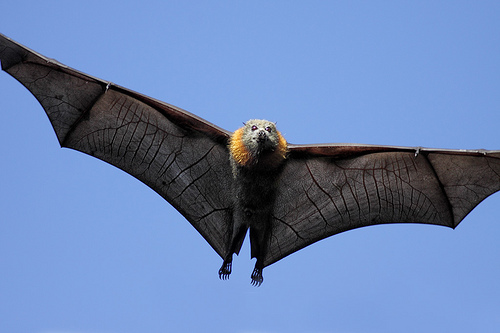Elected representatives in government are in charge of the policy and funding that can make or break saving threatened species. Their decisions and actions matter.
Blair has or used to have 28 threatened animals within its boundaries. One of them is me, the Grey-headed Flying-fox.
We took care to attach appropriate images that are as close to representative of each species as our resources and the availability of images allowed. However, we could not ensure perfect accuracy in every case. Some images show species that share the same genus but not at the species or subspecies level.
Grey-headed Flying-fox
Pteropus poliocephalus
Status: Vulnerable
The Environment Protection and Biodiversity Conservation Act 1999 (EPBC Act) lists threatened species under six categories:
Extinct, Extinct in the wild, Critically Endangered, Endangered, Vulnerable, Conservation dependent. Read more about these categories
Pteropus poliocephalus is found across 128 electorates.
The Grey-headed Flying-Fox is one of the largest bats in the world with a weight of 600–1000 g and a head-body length of 230–289 mm. It is the only Australian flying-fox that has a collar of orange/brown fully encircling its neck. Thick leg fur extends to the ankle, in contrast to other Pteropus species in which it only reaches the knee. As its name implies, the head is covered by light grey fur. The belly fur is grey, often with flecks of white and ginger. The fur on the back shows two morphs which could be related to age, moult or sub-population. One morph has dark grey fur and the other has a pronounced silver or frosted appearance. Winter fur is darker than summer fur with a pronounced moult occurring in June.¹
Explore more about this species on the Atlas of Living Australia


Explore more about the threats facing species on our Resources page.
- Hairy-joint Grass (Arthraxon hispidus)
- Bertya opponens (Bertya opponens)
- Three-leaved Bosistoa (Bosistoa transversa)
- Miniature Moss-orchid (Bulbophyllum globuliforme)
- Ooline (Cadellia pentastylis)
- Callistemon pungens (Callistemon pungens)
- Stream Clematis (Clematis fawcettii)
- Native Jute (Corchorus cunninghamii)
- Cossinia (Cossinia australiana)
- Stinking Cryptocarya (Cryptocarya foetida)
- Leafless Tongue-orchid (Cryptostylis hunteriana)
- Boonah Tuckeroo (Cupaniopsis tomentella)
- Cyperus semifertilis (Cyperus semifertilis)
- Bluegrass (Dichanthium setosum)
- Tall Velvet Sea-berry (Haloragis exalata subsp. velutina)
- Wandering Pepper-cress (Lepidium peregrinum)
- Macadamia Nut (Macadamia integrifolia)
- Small-fruited Queensland Nut (Macadamia ternifolia)
- Rough-shelled Bush Nut (Macadamia tetraphylla)
- Clear Milkvine (Marsdenia longiloba)
- Cooneana Olive (Notelaea ipsviciensis)
- Lloyd's Olive (Notelaea lloydii)
- a grass (Paspalidium grandispiculatum)
- Lesser Swamp-orchid (Phaius australis)
- Mt Berryman Phebalium (Phebalium distans)
- Shiny-leaved Condoo (Planchonella eerwah)
- Plectranthus habrophyllus (Plectranthus habrophyllus)
- Plectranthus leiperi (Plectranthus leiperi)
- Nightcap Plectranthus (Plectranthus nitidus)
- Austral Cornflower (Rhaponticum australe)
- Scrub Turpentine (Rhodamnia rubescens)
- Native Guava (Rhodomyrtus psidioides)
- Quassia (Samadera bidwillii)
- Ravine Orchid (Sarcochilus fitzgeraldii)
- Blotched Sarcochilus (Sarcochilus weinthalii)
- Sophora fraseri (Sophora fraseri)
- Austral Toadflax (Thesium australe)
You are in federal electorate Blair.
